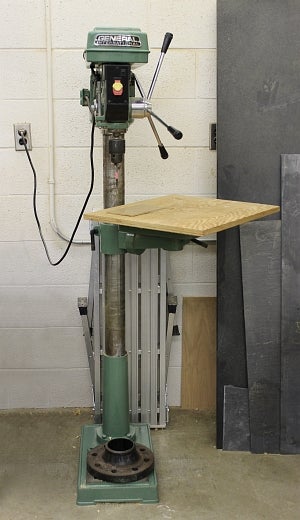Description and uses
The drill press allows the operator to consistently drill holes to precise angles and depths. In addition, the speed can be easily adjusted to directly correspond to the type of material and the type of drill bit used.
With the machine turned off, place the drill bit in the drill chuck and hand tighten, making sure that the jaws of the drill chuck are not clamping down on the cutting portion of the bit. Tighten the drill chuck with the chuck key. Remove the chuck key before you turn on the drill press. Do not place it on the drill table. (To ensure safe operation, clear the table of any tools that are not part of your drilling operation.) Make sure that the bits is properly aligned by briefly turning on the drill.
Line up your workpiece and securely clamp it to the drill press table. Switch the drill on and lower the cutting bit by rotating the handle towards you. Do not force the machine. Let it cut at an even rate. After you have drilled through and removed your material, clear the drill table of all debris. Once you are done drilling, remove and return the bit.
Drill press hazards
The drill press is very powerful tool. Never drill freehand. Always clamp the workpiece. A drill bit can become seized in the workpiece causing it to rotate with the spindle and can cause serious injury.
If the chuck key is not removed immediately after locking or unlocking a bit, it could be thrown off the rotating spindle and cause serious injury.
Further considerations
- The table of the drill press can be raised and lowered, rotated, and tilted. Make sure all the table clamps are tightened before you turn on the power.
- The drill press is provided with a depth stop adjustment, enabling you to cut holes to equal depths.
- Longer pieces may require a work support.
- Generally, increasing the bit size increases the danger of the bit seizing. Some bit styles such as spade (chisel) bits are especially prone to seizing. Ensure that your workpiece is properly clamped and that you are using the correct speed for your type of operation. When in doubt, ask the woodshop technician for assistance.
Cautions
- Eye protection is mandatory.
- A dust mask is recommended for plywood and particleboard and required for MDF and certain toxic woods.
- Only operators trained in the operation of a drill press are allowed to use the tool.
- Never start the machine with the drill bit touching the workpiece.
